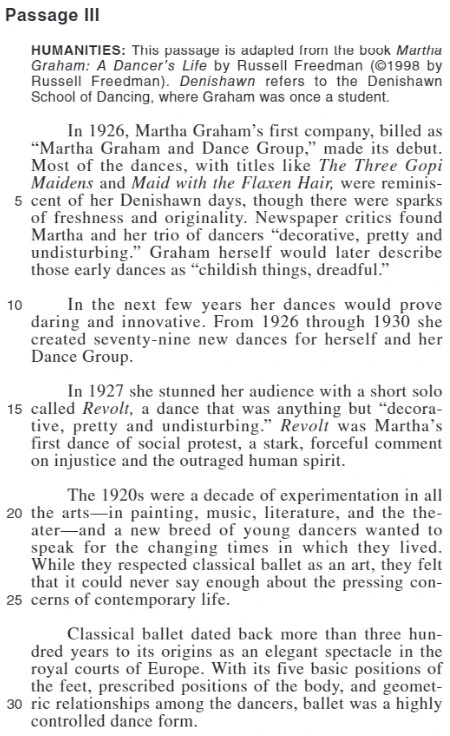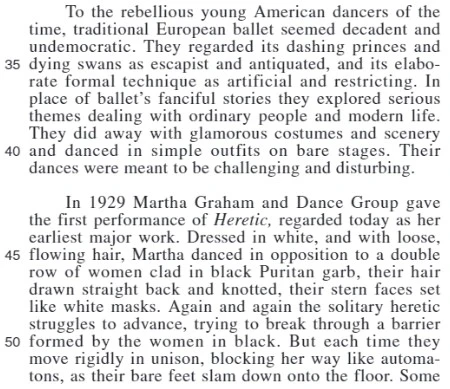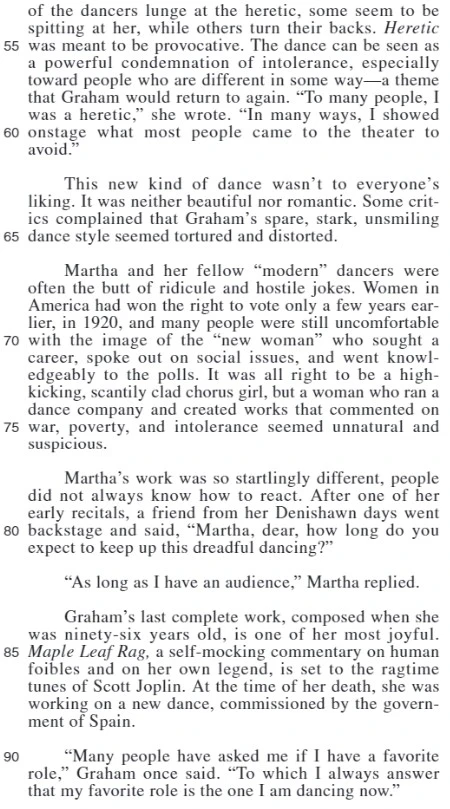Section: Reading 1 Likes
Passage III - In 1926, Martha Graham’s first company, billed as (September 2023 - G01)



Questions from Passage III
21) Which of the following statements best describes the nature of this passage?
A. A biographical sketch that gives nearly equal attention to both Graham’s work and her personal life.
B. A chronological account of Graham’s life begin-ning with her early childhood and ending with her Denishawn days.
C. A description of Graham’s work and philosophy that focuses on placing her early dances into his-torical context.
D. A depiction of Graham’s philosophy of dance and how that philosophy had come to be seen as out-dated by the time of her death.
22) The author would most likely describe Graham’s dancing as:
F. decorative and pretty.
G. joyful and lighthearted.
H. stark and overly simplistic.
J. daring and rebellious.
23) Based on the passage, Graham in later life would most likely characterize her dance company’s debut as:
A. a promising beginning.
B. an immature presentation.
C. an appeal for understanding.
D. a quest for modern expression.
24) According to the passage, which of the following features is NOT associated with classical ballet?
F. Whimsical story lines.
G. Challenging themes.
H. Prescribed positions.
J. Restrictive techniques.
25) As depicted in the passage, Graham’s role in Heretic can best be described as one in which her character is:
A. unwilling to accept rigid social standards.
B. able to overcome difficulties easily.
C. ignorant of what others think of her.
D. unaware of differences that make her unusual.
26) The author claims that many people in the 1920s who were uncomfortable with the activities of the “newwoman” found it more acceptable for women to:
F. vote knowledgeably in elections.
G. run a business.
H. dance to advocate social causes.
J. dance suggestively in a chorus line.
27) It can reasonably be inferred from the passage that part of the encouragement Graham received for her dancingcame from:
A. the reaction of friends from her Denishawn days.
B. early and widespread support from critics.
C. recognition of her growth as a classical dancer.
D. the appreciation of an accepting audience.
28) Based on the passage, the period from 1926 to 1930 for Graham’s dance company could best be described as atime of:
F. uninterrupted tranquility.
G. critical acclaim.
H. rich productivity.
J. popular acceptance.
29) As quoted in the passage, Graham suggests that Hereticis symbolic of:
A. her painful childhood experiences.
B. the reaction to her work as an adult.
C. her experience of being criticized for her religious beliefs.
D. the way she was often rejected while attending the Denishawn School of Dancing.
30) The critics referred to in the eighth paragraph (lines 62−65) were most nearly complaining that Graham’sdancing was:
F. misleading and sentimental.
G. awkward and contorted.
H. meandering and second-rate.
J. agonizing and unoriginal.
Solution
Correct answer:
21 - C
22 - J
23 - B
24 - G
25 - A
26 - J
27 - D
28 - H
29 - B
30 - G
Exam Edition: September 2023 - G01
Exam Year: 2023
Related topics: Textual Comprehension, Interpretation and Reading of Text